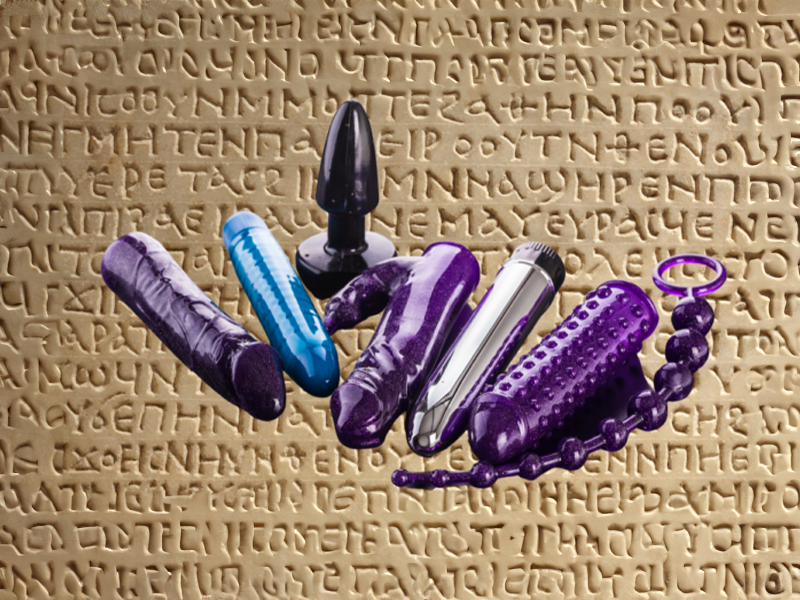A Delightful Didactic History of Dildos
Whether for fashion, décor, worship, or for fun, dildos are a part of human history.
The next time you reach for your Hitachi Magic Wand or your rabbit, consider for a moment the ancient cultures that had to manage without these fine inventions. That doesn’t mean they went entirely without sex toys though. Physical representations of the phallus have been around for almost as long as there have been penises. Whether for fashion, decor, worship, or for fun, dildos are a part of human history. So let’s take a look at the long, strange trip dildos have taken.
In the Beginning …
The first known dildo recovered by paleontologists dates to the Paleolithic era. Made of siltstone and polished to a high gloss, the debate rages on about whether its primary purpose was for religious ritual or personal pleasure. To my mind, this debate has more to do with puritanical paleontologists who can’t conceive of a society where religion and sexuality commingle. The fact remains that dildos made of carved stone or bone were widely discovered among normal personal artifacts like combs and sewing needles. I imagine this eventually led to the invention of nightstands, and nightstand drawers.

A 30,0000-year old siltstone phallus found in Germany. Source: University of Tubing
Leave it to the Greeks and Romans to take the next leap forward. To get a feel for the time, it’s important to keep in mind that Greeks and Romans were polytheists who worshiped a variation of Dionysus, god of wine and fertility. Also called Bacchus or Liber, worship of the sex god included parades through the streets, where giant phalluses were raised up like protest signs. At the end of a marital fertility parade, a maiden would come forth and crown the religious phallus with a wreath of flowers.

A phallic object from 4,000 to 6,000 BCE carved from antler bone. Found in Sweden. Source: Peter Zetterlund, Swedish National Heritage Board
We also know that both male and female Romans and Greeks used dildos for pleasure. In Aristophanes’ anti-war comedy “Lysistrata,” women discuss using and sharing dildos while withholding sex from their partners in an effort to stop the war. Men going off to war also gave their wives so-called “olisbos” to prevent “hysteria,” which was then thought to be caused by lack of sperm. Since these olisbos did not actually contain sperm, I’m not sure they’d really thought that one through.

A Roman dildo or double dildo, Source: Unknown
Historically, the connection between female hysteria and dildos was something male doctors had a hard time letting go of. Romans are also thought to have invented double dildos for use in ceremony, or with a friend. The Greeks are responsible for the first use of leather or animal intestine to cover a carved penis, adding a more natural feel and a complexity of texture.
Take THAT, Silicone!
There’s a funny historical rumor that it was legendary seductress Cleopatra who invented the first vibrator. Rather than being carved from wood or rock, this one consisted of a gourd hollowed out and filled with … wait for it … angry bees. If true, that might make Cleopatra the biggest risk taker in all of history. But then, what else would you expect from a people who thought crocodile dung was the best method of birth control? Although the bees make for a better story, it’s more likely that Cleopatra used the same lacquered wood or stone dildos as the other ladies of her time. There is even record of Julius Caesar giving Cleo an elaborately carved, gold inlaid penis “sculpture.” Whether she ever tried it out is something we’ll probably never know. (Learn more about the vibrator’s strange history in Vibrators: Bigger and Generating More Buzz Than Ever.)
The Chinese were also considered great innovators in female masturbation. Back in the day, wealthy Chinese men were apt to have too many wives for them to service regularly. It was thought that providing penis substitutes would keep these wives faithful and prevent them from resorting to lesbianism. Ancient Chinese dildos have been discovered that were cast of bronze and other metals. Some of these were hollow and allowed liquid to be released at the appropriate time. Fancy!
In India and Persia, virgins were sought after and yet somehow reviled. You’d think the people who gave us the “Kama Sutra” would be a little more sex-positive. Blood from the hymen was thought to be unclean and best avoided by new husbands. Therefore, the local holy man would show up on the wedding night and use a large stone dildo to break the hymen. Sometimes this was done in the center of town, either in celebration or to confirm the virginity of the bride. In the story “One Thousand and One Arabian Nights,” dildos are discussed as being made from gold or silver, or intricately carved and inlaid ivory.
The use of dildos remained more or less the same for a long portion of history. Some cultures didn’t create dildos at all, preferring more natural items like gourds, plantains or unripe bananas. Like everything else in the Renaissance, dildos of this era were ornate, inspired and appreciated for their artistic merit. In fact, the word dildo comes from the Italian “diletto,” meaning “delight.” Even as Christianity entered the scene and puritanical values gained a foothold, substitute penises were still an active industry. After all, they still had to deal with the menace of “feminine hysteria.”
Hysteria, Womb Problems and Paroxysm
As the 20th century dawned and technology advanced, new materials were incorporated into the manufacture of dildos. Rubber was the hot new material for a time. Then something amazing happened. Electricity. One might argue that there’s a big difference between a dildo and a vibrator, especially an early vibrator. And that’s true. But when you’re talking about the scourge of hysteria in females, a nod’s as good as a wink to a blind bat.
It was believed that “female troubles,” which ranged from headaches and fatigue to irritability and depression – could be solved through inducement of hysterical paroxysm, which you and I would call an orgasm. Hysteria was considered a “womb problem” and was the sort of thing Hippocrates referred to as “anything that made the woman troublesome to those around her.” I admit, I had no idea Hippocrates was such a sexist jerk.
During medical appointments, doctors began helping women have orgasms in a very hands-on way. When the task became too time consuming, General Electric stepped in by making its fifth electrical home appliance. Yes, the vibrator was actually the fifth commercially available electric appliance, after the tea kettle, bread toaster, sewing machine and fan. These handy vibrators were designed to get those troublesome women un-hysterical, so doctors could go back to important work like inventing Viagra and curing baldness. (Now that you know that vibrators are considered appliances, be sure to ask if one is included next time you’re buying a house.)

Old vibrators looked a bit scary … like power tools.Source: Flickr/niallkennedy
Electricity is certainly not the only modern innovation in dildo technology. The introduction of silicone was a great leap forward in the functionality of dildos used for sexual stimulation. Silicone is hypoallergenic, feels more like real skin than other non-porous materials, and does not degrade when used with water-based lubricant. Glass dildos are another way that form and function meet artistry. Modern tempering techniques result in blown glass that is thick and strong – just what most of us are looking for. Glass dildos are available in lots of different sizes in nearly infinite designs, and are also non-porous. (Yes, glass! Check out these beauties.)
We’ve Come a Long Way, Baby
These days, dildos are available in every variation imaginable, for every taste and experience level. Some states have actually taken the time to pass laws restricting how many dildos a person can keep at home. Try though I might, I fail to see the inherent threat of a large collection of phalluses. Ancient Rome’s double-ended dildos remain popular today. Cleopatra’s angry-bee-filled clitoral gourd, on the other hand, never really caught on.
Whether you’re trying to cure feminine hysteria, stop the Peloponnesian war, or just enjoy a couple of orgasms, dildos have always been – and will continue to be – at your service. The best part is, getting one is a lot easier than it used be. And you won’t have to carve it yourself.





